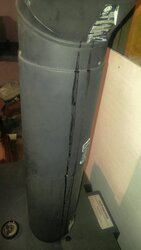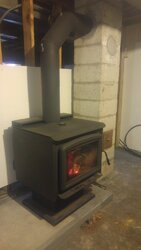Too cool applies to creosote condensation temperature, non-cat or cat."Too cool" only applies to secondary burn stoves. The cat converts all that combustion gook into heat. I can get the stove top down to 175 and still be in the active region.
2016-17 Blaze King Performance Thread (Everything BK)
- Thread starter webfish
- Start date
-
Active since 1995, Hearth.com is THE place on the internet for free information and advice about wood stoves, pellet stoves and other energy saving equipment.
We strive to provide opinions, articles, discussions and history related to Hearth Products and in a more general sense, energy issues.
We promote the EFFICIENT, RESPONSIBLE, CLEAN and SAFE use of all fuels, whether renewable or fossil.
You are using an out of date browser. It may not display this or other websites correctly.
You should upgrade or use an alternative browser.
You should upgrade or use an alternative browser.
- Status
- Not open for further replies.
kf6hap
Minister of Fire
Yes. I agree below ~275F creosote can form but it just does not seem to happen in my system. In the shoulder season my flue spends a lot of time below 275F.
kf6hap
Minister of Fire
Flue stack probe only. Creosote does build up within my Ashford 30.1 in the shoulder season but with a good hot firing things (including a badly gunked window) clean up nicely.
kf6hap
Minister of Fire
Wondering what the stack temp is? My stove top thermometer is just forward of the cat thermometer. For medium low and low burns, after things have stabilized for a couple of hours, the stove top and flue stack temps closely match.
Ashful
Minister of Fire
Too cool applies to creosote condensation temperature, non-cat or cat.
You're assuming there is creosote left to condense in that water vapor, but I argue the superior efficiency of BK ensures there ain't much creosote remaining in the exhaust.
kf6hap
Minister of Fire
I think that if a BK is properly set up and operated these very low temps are usually not a problem. Get an inspection mirror and a good LED flashlight and check to be sure. Do it. Good burning practice requires checking. Once a month until you are satisfied all is well. I check now and then. Better safe than sorry. My wood is ~15% so I don't sweat this too much. Always do the 20 minute full throttle load char at the reload. The MC of red hot wood is quite low.
Depends on the wood moisture content, chimney exposure, stove thermostat setting and outdoor temps. 20% is still going up the chimney. Many people with cat stoves here seem to be reporting more sote when cleaning than non-cats. I would attribute that to cooler flue temps. You may not be seeing as much if you are running the stove hotter?You're assuming there is creosote left to condense in that water vapor, but I argue the superior efficiency of BK ensures there ain't much creosote remaining in the exhaust.
kf6hap
Minister of Fire
As it gets colder (now) I shut doors to the other parts of the house and my 1590 sqft house shrinks down to 860 sqft so I run the stove on a low setting down to about 30F. Below 30 it is run at at "medium" fire. My stove is at medium to low its whole life. I save huge amounts of wood by shrinking the house and get gastronomical burn times. For most of the burn the flue is between 200-350. Mostly pine and 20% oak.
I don't think my setup is anything special but my wood is always dry, I do the 20-30 minute char every reload and turn the thermostat down in 3 steps.
I don't think my setup is anything special but my wood is always dry, I do the 20-30 minute char every reload and turn the thermostat down in 3 steps.
So I went up onto the roof to check how the flue liked these low flue temps. I can conclude that very dry wood, active cat, 24/7 burning, and 250-350 flue temps lead to a gross, tarry, shiney, plugged up chimney cap. I was shocked. I cleaned this goop off with a screwdriver and needed CARB cleaner to remove the gunk from the tool. Luckily the major goo was just at the top.
I'm running hotter now to maintain 400 internal stack temps which is still very cool. I just hope I can burn that tarry goo into something that the sooteater can break loose.
I'm running hotter now to maintain 400 internal stack temps which is still very cool. I just hope I can burn that tarry goo into something that the sooteater can break loose.
kf6hap
Minister of Fire
How far down from the top is the tarry gooey stuff?
4" into the pipe and the whole cap was slathered in it. Farther down the pipe was a thin shiny layer as far as I could see.
Agent
Member
I noticed the same after my first two weeks of burning. My assumption is that it was just creosote formation from when the bypass is open during reloads. It seems logical since you are mixing the cool/cold chimney with very smokey moist bypass exhaust. I was planning on looking later after it got cold and the stove had to be run harder in case that would change the nature of that coating.
Ashful
Minister of Fire
Dunno what you're doing wrong, Highbeam. Two flues here, 15' and 25', and nothing but popcorn in either, from running two BKs 24/7.
Ashful
Minister of Fire
would attribute that to cooler flue temps. You may not be seeing as much if you are running the stove hotter?
I marked the thermostat settings that give me a 24 hour burn on the 15' chimney in the newer wing of the house, and 12 hour burns on the 25' chimney in the old part of the house. That's where I run them, based on my ability to keep them loaded, letting the boiler pick up any difference in demand. I would say 12 hours is beyond slow for most stoves, and 24 hours is something only a BK can do, so I wouldn't say I'm running the stoves very hot.
Different stove and very different heating environment. Highbeam's heating a house, not a cavern. With our mild weather his stove is set as low as it can go without stall.
https://www.hearth.com/talk/threads/dirty-blaze-king-windows.157847/#post-2118843
Didn't we just have a posting this morning of an Ideal Steel? At 25 hrs there was a very healthy and hot coal bed still glowing in the stove.and 24 hours is something only a BK can do,
https://www.hearth.com/talk/threads/dirty-blaze-king-windows.157847/#post-2118843
Last edited:
Dunno what you're doing wrong, Highbeam. Two flues here, 15' and 25', and nothing but popcorn in either, from running two BKs 24/7.
I believe I was simply running too low and slow. I have found that the lowest possible burn rate isn't just limited by the cat going inactive but also limited by the need to maintain a minimum flue temperature to avoid the nasty wet tar accumulations. I'm cool with popcorn.
Oh and my settings were giving way more than 24 hours with low btu woods so the burn rate was much lower than yours.
Ashful
Minister of Fire
Didn't we just have a posting this morning of an Ideal Steel? At 25 hrs there was a very healthy and hot coal bed still glowing in the stove.
https://www.hearth.com/talk/threads/dirty-blaze-king-windows.157847/#post-2118843
Not impressed at all. My 24 hour burns are on a medium'ish setting, and I can easily exceed 36 hours on a 2.75 cu ft firebox. Until they hit 40 hours in a stove that size, they will be a very distant second best.
Lokidric
New Member
Did anyone come to a conclusion with regards to the dripping black goo from the stove pipe on new install? This sirocco 30.1 has been running for over a month now and I just noticed this. Burning really dry larch getting 24 hour burns with hours of fuel still in the box. I always burn on high for thirty minutes before turning it down. 19feet of vertical chimney where the black pipe 'T's in. Thanks




Last edited by a moderator:
I do 24 hour burns routinely with partial loads. It used to be really exciting, now it's just a normal part of owning a BK!
Last edited:
Has it rained recently? Maybe water made its way into your chimney? Does it have a liner?Did anyone come to a conclusion with regards to the dripping black goo from the stove pipe on new install? This sirocco 30.1 has been running for over a month now and I just noticed this. Burning really dry larch getting 24 hour burns with hours of fuel still in the box. I always burn on high for thirty minutes before turning it down. 19feet of vertical chimney where the black pipe 'T's in. ThanksView attachment 188442 View attachment 188443
Lokidric
New Member
Has it rained recently? Maybe water made its way into your chimney? Does it have a liner?
Hi.
Yes, it's a brand new chimney. Double walled insulated stainless all the way up with a new cap. I has been raining alot though. Not sideways driving rain but mostly just straight down. Rain would have been my last guess.
Hard to see but is the upper part of the 45º stove pipe elbow (where the drip is occurring) inserted into the connecting pipe above it or is it vice versa with the male end of the connecting pipe inserted into the female end of the elbow below it?
I've actually had water make it's way in through the seam on some class A chimney brands, caulked the vertical Seam in the pipe, problem solved.Hi.
Yes, it's a brand new chimney. Double walled insulated stainless all the way up with a new cap. I has been raining alot though. Not sideways driving rain but mostly just straight down. Rain would have been my last guess.
- Status
- Not open for further replies.
Similar threads
- Replies
- 48
- Views
- 2K

